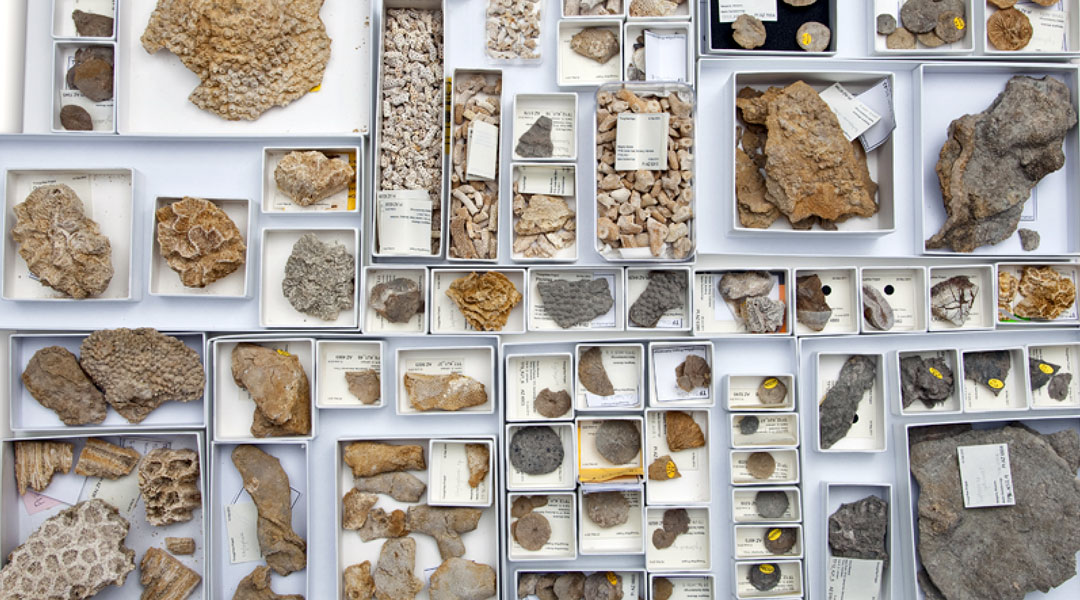OceansWhat does it take to study the ocean?
The ocean is vital to life on Earth, and there are scientists worldwide who dedicate their lives to studying it.
From making predictions with fossils to treating diseases with sponges, scientists find new and innovative applications thanks to what they learn from the ocean and its inhabitants.
Dr Suzanne Williams, Dr Ana Riesgo Gil and Prof Richard Twitchett are three Museum scientists, each helping to shape our knowledge of our planet's watery worlds.
Inspired by the sea
Dr Suzanne Williams is an evolutionary biologist whose research focuses on molluscs, a group that includes squid, marine snails, clams and oysters. However, her interest in life in the ocean began as a child.
'We used to go to the seaside for a holiday every year for two weeks, and I would go out and collect shells. I probably decimated a whole population of a particularly pretty iridescent trochid species, because they were so lovely,' she says.
'One of my earliest jobs was working on the Great Barrier Reef, looking at giant clams. My job was half fieldwork, diving and collecting tissue samples, and half lab work, looking at the genetic relationships among wild populations. So that very much strengthened my interest in the sea and in molluscs.'
Sponges expert Dr Ana Riesgo Gil began her study of the sedentary animals during her PhD, when she investigated the evolution of multicellularity.
'I started diving in the Mediterranean, and the first time that I collected a piece of sponge I felt it contract very slowly. So I thought, they're living animals but they don't look like them, which makes them even more interesting,' she explains.
'Right now at the Museum, we're studying deep-sea sponges, which we know almost nothing about.'
Palaeontologist Prof Richard Twitchett's work was first inspired by Earth's long history of extinction events.
'There is a fascination with the death and destruction of these events, but I became more interested in how marine ecosystems recover from these big traumas. At the time when I started my research, there were very few people looking at recovery.
'There were a lot of questions that people didn't know the answer to - some that we still don't know the answer to,' he says.
How to study the ocean
The researchers rely on the Museum's vast collections. Millions of specimens including whales, fishes, molluscs and microscopic organisms are housed in London.
Suzanne, Ana and Richard all make use of these in different ways.
Richard's work focuses mainly on fossils of marine invertebrates. He uses animals from the past to test predictions of what will happen to our oceans and its inhabitants in the future.
'We should be able to test predictions by going back and looking at warming events in the past. We look at how past ocean ecosystems responded to change across the world as it warmed and cooled.
'Animals such as oysters and brachiopods secrete their shells from elements dissolved in seawater, so they are a record of the chemical composition of the seawater itself. This chemical signature can be preserved during fossilisation. If we measure the chemical composition of fossil shells, we can work out what the water was like millions or hundreds of millions of years ago, when the animals were alive.'
By looking at the responses of the animals in the past, it is possible to predict how present animals and ecosystems might react to future changes.
In contrast, Suzanne's research addresses the biodiversity of marine molluscs. Her interest is in tropical areas like the Indo-West Pacific, which is renowned for its species richness. She now also focuses on pigmentation in mollusc shells.
'I'm interested in what creates the diversity in appearances, how we get these different colours in shells. We know very little about this,' she says.
'We were able to determine that the colour we observe in some shells is due to a class of pigments known as porphyrins. Porphyrins are produced as a result of changes to the haem pathway and in humans. Problems with this pathway can result in a group of metabolic disorders called porphyria.
'There are two places in the UK that test for porphyria. I sent shell extracts to King's College Hospital and they were able to test for the pigment in my shells and identify the porphyrins responsible for pink-red and yellow-brown coloration.'
It was also found that although some shells may be the same colour, the pigment is not always the same.
'In these cases, the pigments are coming from different evolutionary pathways,' Suzanne explains.
Why study the ocean?
From rising water temperatures and acidification to large-scale fishing practices and the introduction of plastics, the ocean is rapidly changing.
Plenty of researchers are trying to document the ocean's condition before it is too late.
Richard notes, 'It is really important for us to understand what is in the ocean right now. A lot of the big extinction events back in time were related and probably driven by climate change, particularly global warming.
'I'm interested in the prediction that marine animals are going to get smaller as the oceans warm. If you warm any water, it will hold less oxygen, and animals that don't get enough oxygen won't be as big. We have shown that becoming smaller is a common response to past warming and extinction in many types of marine animals.'
This change could have severe impacts on the whole ecosystem and how it functions.
Trawling and other fishing activities are causing damage to sponge grounds, resulting in a race to find ways of protecting the animals.
'We want to try and understand the ecosystem function of the sponge grounds in the North Atlantic to see what steps we should take to protect them,' says Ana.
'There are also people interested in the natural products of sponges for biomedicine, and the collagen and skeletons for bioengineering.'
The Museum's role in marine science
The Museum employs more than 300 scientists who work behind the scenes in a vast number of areas of expertise. Their research expands the knowledge of our natural world.
The Museum's collections are vital, helping scientists like Richard see what has happened to our planet over the last two centuries.
'We have an archive of specimens going back 200 years,' Richard explains. 'Each of those specimens, potentially, is an archive of the environmental conditions of the time - even though no one was recording that then. You can directly answer questions of how much the world has actually changed with modern climate change.'
'You can never really reproduce that in any way other than from collections.'
Research is helping to spread messages, not only of climate change and risks, but also positive stories of conservation and Earth's staggering diversity of species.
'If we don't do any research, then we can't take any action because we don't know what's there. Providing studies of biodiversity in the oceans right now should engage actions by conservation funding agencies or NGOs,' explains Ana.
Suzanne says, 'There is a lot of really good applied science to do. But we also need to investigate blue-sky science. You never know the value of what you learn until you learn it.'










Don't miss a thing
Receive email updates about our news, science, exhibitions, events, products, services and fundraising activities. We may occasionally include third-party content from our corporate partners and other museums. We will not share your personal details with these third parties. You must be over the age of 13. Privacy notice.
Follow us on social media